How to Get to Machu Picchu? New Rules for 2024/25

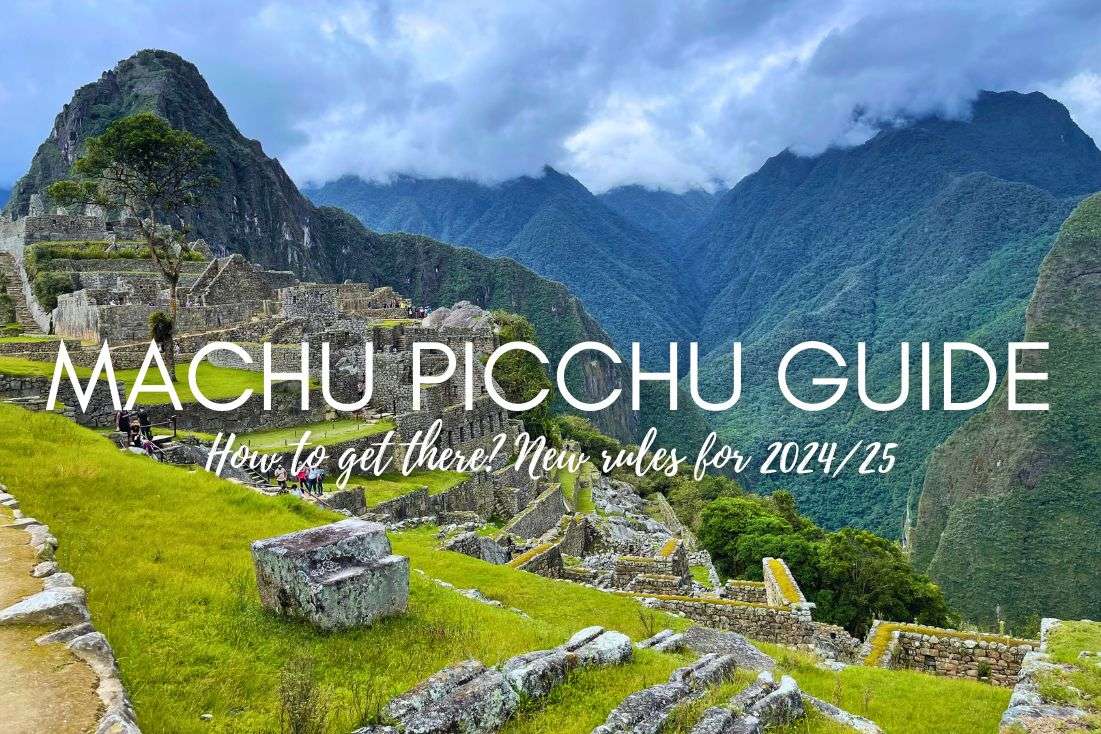
I’ll be honest—I thought Machu Picchu would be lame and overhyped. A bunch of old rocks, some llamas, and a million tourists? I wasn’t buying it. But guess what? It’s downright amazing! And I’m not just talking about the city itself. The surrounding scenery is jaw-dropping, too, which catapulted the Inca city to my number 1 thing to do in Peru.
The location on top of a mountain, the hours it takes to even get there, the fog that rolls in and out, the views in every direction—it all feels like you’ve stepped into a secret world. You’ll feel grateful, humble, and stoked all at once.
So, let me walk you through the steps of how to visit Machu Picchu, starting with the options of getting there from Cusco (without hiking), and how to navigate the new ticket system (hint: it’s changed a lot in 2024!). You can do all this without a tour, on your own, in true independent travel fashion. Like me.
Pro tip: Take a look at my 2-week Peru itinerary for the trip plan I recommend for the ultimate Peru experience... and to acclimatize properly and avoid feeling like you’ve just run a marathon after walking up a few stairs in Cusco!

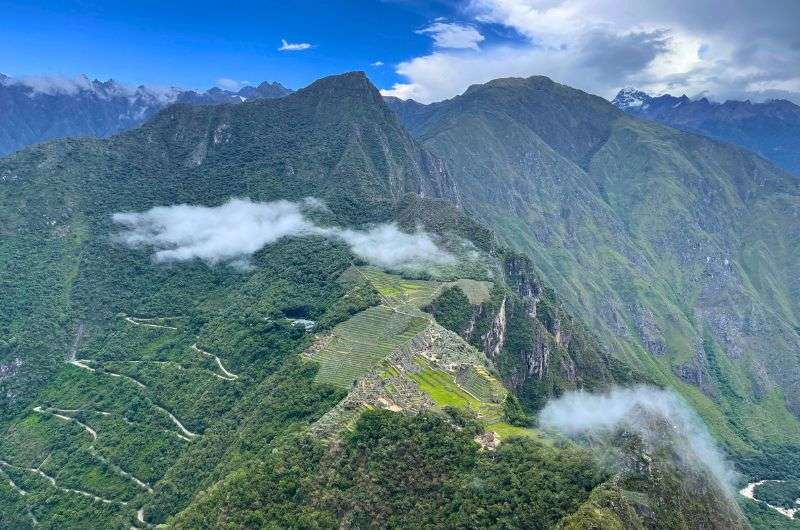
Machu Picchu
1. How to get to Machu Picchu: The basics for your visit
Here’s everything you need to know before you visit Machu Picchu without a tour:
Do you need a permit for Machu Picchu? No
- No permit needed, just your ticket.
- However, tickets must be bought up to 3 months in advance—especially during peak season (June to August). Machu Picchu isn’t for those of you who like to plan trips last minute.
How to get to Machu Picchu: Drive, train, and bus
- You can’t drive there! Most visitors take a train from Ollantaytambo (1.5 hours) to Machu Picchu Pueblo (Aguas Calientes). From there, it’s a 20-minute bus ride to the entrance.
- For the hikers: You can also walk the Inca Trail or other multi-day treks if you’re up for the challenge; but this article is about how to get to Machu Picchu without hiking.
Machu Picchu entrance fees and tickets
- The ticket system was updated in June 2024. You now pick an hourly time slot and choose one of 10 routes on 3 circuits to follow through the ruins. Details of these below.
- You’re allowed 4 hours inside the site, and re-entry isn’t allowed.
- Prices: USD 40 for a basic entry, USD 53 if you’re hiking to one of the mountains at Machu Picchu.
Visitor limits: 2,400 people at any given time
- The daily visitor limit is 5,600 people in peak season, 4,400 people in other months, and most days sell out early. The mountain hikes are limited to 200 visitors a day! Book tickets well in advance if you’re visiting during busy months or have a rigid travel schedule.
What’s the best time to visit Machu Picchu?
- If you want fewer crowds, aim for the shoulder seasons of April-May or September-October. The dry season (June-August) means clearer skies, but it’s also peak tourist time. Otherwise though, you can visit in any month.
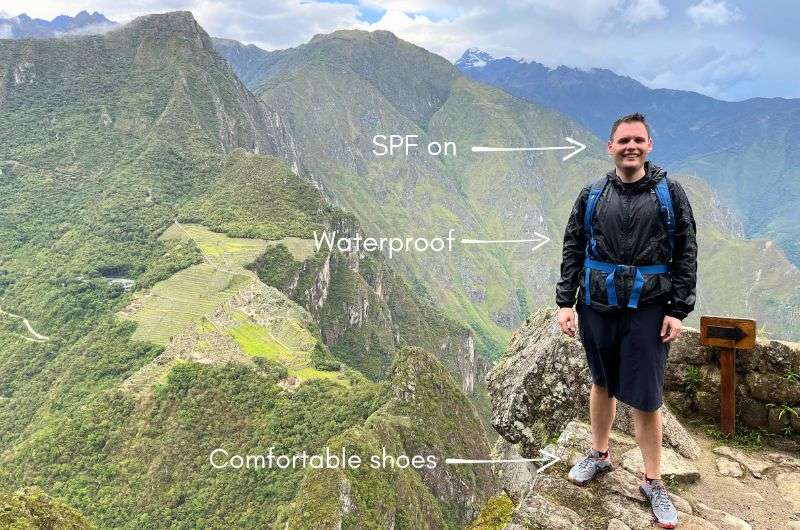
Here you see the exemplary visitor of Machu Picchu
What should you pack?
- Don’t forget your passport (you’ll need it multiple times), rain gear (also during dry season!), insect repellent, comfortable shoes, and some layers—because Machu Picchu nights and early mornings can be very chilly.
Food and facilities
- There are no facilities inside the ruins—no bathrooms, no restaurants—so make sure you go before you enter and pack snacks and water (but not too much water… unless you enjoy being thirsty for adventure and a restroom).
Sometimes, all you need to do is take the first step... I've filtered out the best hotels in Machu Picchu for you
Save it for yourself to come back to later, or share with your friends on social media!
I've already planned your ititnerary for the trip, complete with my travel tips.
2. Machu Picchu map: Getting from Aguas Calientes
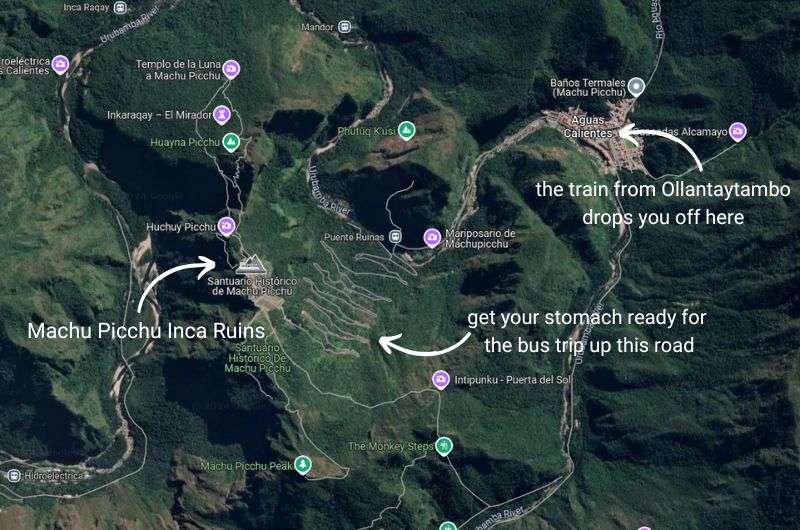
Getting to Machu Picchu requires a scenic train journey and a hair-raising bus trip
3. Machu Picchu map: Inside the Inca ruins
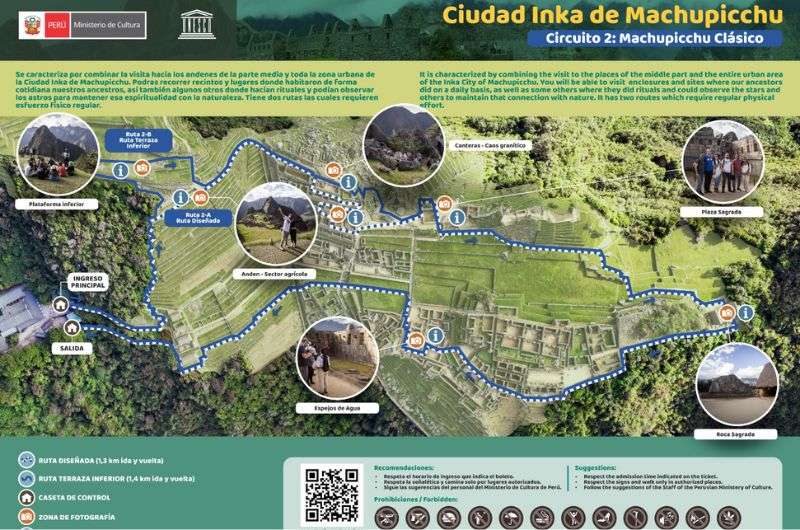
The new circuit 2 offers the most comprehensive Machu Picchu routes (2A and 2B) (maps of all routes on the official website: www.machupicchu.gob.pe)
4. Why is Machu Picchu so famous?
Machu Picchu is often called the lost city of the Inca Empire, but here’s a twist: it’s not really. That title actually belongs to Vilcabamba, where the Incas made their last stand against the Spanish. While Vilcabamba was the final Inca hideout, Machu Picchu was more like the Incan royal family’s swanky vacation home—built in the 15th century, likely for Pachacuti, the empire’s ruler.
Let me tell you the story of how Machu Picchu snagged the Lost City title: Perched on a mountain in the middle of nowhere (aka the Andes Mountains in Peru), Machu Picchu managed to stay off everyone’s radar until American explorer Hiram Bingham stumbled upon it in 1911 (with the help of locals who always knew it was there), sparking worldwide fascination. Since then, Machu Picchu has become a symbol of Inca ingenuity and a top bucket-list item for every traveler. It’s a UNESCO World Heritage Site and one of the New 7 Wonders of the World.
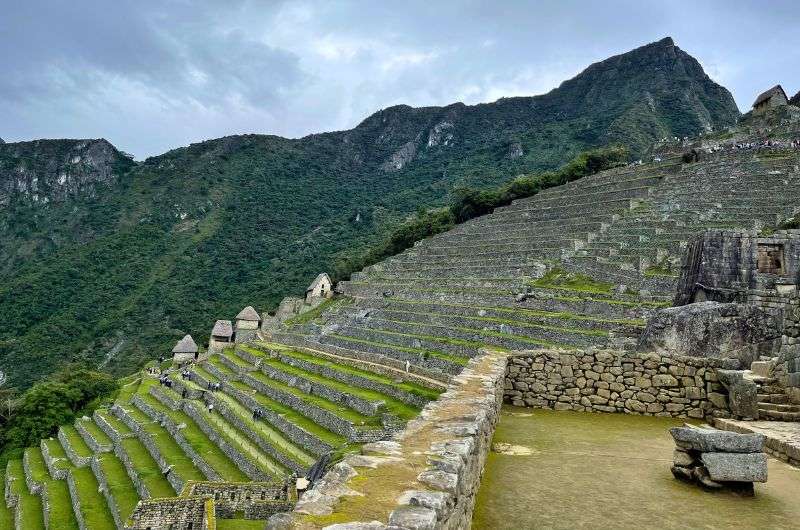
Because it’s amazing!
5. My Machu Picchu travel tips:
- Always have your passport with you. You’ll need it multiple times during your visit and on the train and bus to get there. Basically, all your tickets are tied to your name and passport number, and they will be making sure it’s you (over and over again).
- Dress in layers, especially in rainy season (a poncho will come in handy for that—we had a huge downpour in the afternoon!). Remember, it can rain even in the dry season, and evenings and mornings are chilly.
- The air is fine: You don’t have to worry about altitude sickness at Machu Picchu, though the air is a tiny bit thinner (the city sits at 2,400 m or 7,800 ft). You’ll need to worry much more about staying in Cusco, which is way up higher than Machu Picchu.
- What not to pack: Selfie sticks aren’t allowed at the Machu Picchu citadel, nor are drones or tripods. Large backpacks or other big bags aren’t either. Just bring water and your passport and you’re good.
- No amenities at Machu Picchu: There are no facilities once you enter Machu Picchu, so go pee beforehand and take snacks and water with you (but not too much, because then you’ll have to pee again).
- Stay the night in Aguas Calientes. It’s a tourist town with all the amenities, great restaurants, and is surrounded by stunning scenery. Sumaq Machu Picchu Hotel is where you want to book a room. It’s a 5-star hotel with Inca-inspired décor and beautiful location right by the Urubamba River.
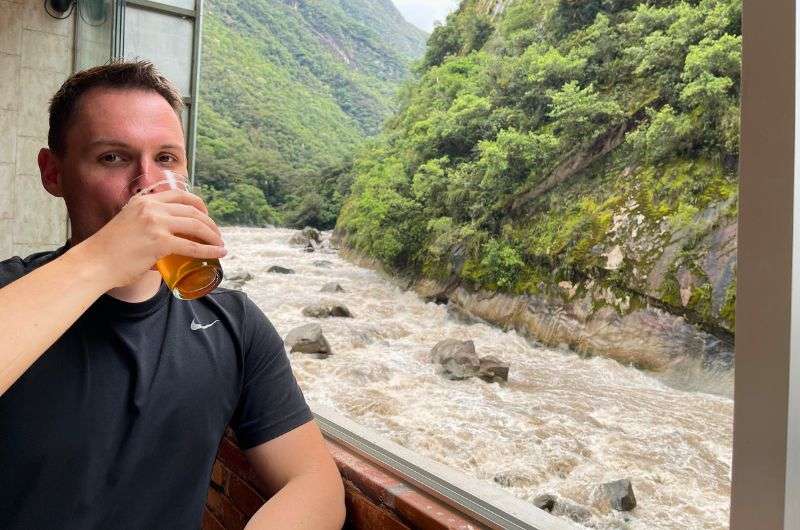
Aguas Calientes is a solid base for the night
6. How to get to Machu Picchu from Cusco
Machu Picchu is up on the tippy top of a mountain, so it’s not exactly easy to reach. Not even the closest town, Aguas Calientes, is serviced by a road of any kind. So, how do you get to Machu Picchu?
If you’re like me, you’ll be renting a car to drive yourself as far as you possibly can (Ollantaytambo). After that, it’s public transportation all the way.
Getting from Cusco to Machu Picchu in 3 steps:
1. Drive or take the bus to Ollantaytambo from Cusco (1–2 hours),
2. take the train from Ollantaytambo to Aguas Calientes (1.5 hours), and
3. hop on a shuttle bus from Aguas Calientes up to the Machu Picchu Inca city (20 minutes).
Walk around up there like an Inca, and then do the same thing backwards to get away. (Not the walking around bit, it isn’t necessary to walk backwards.)
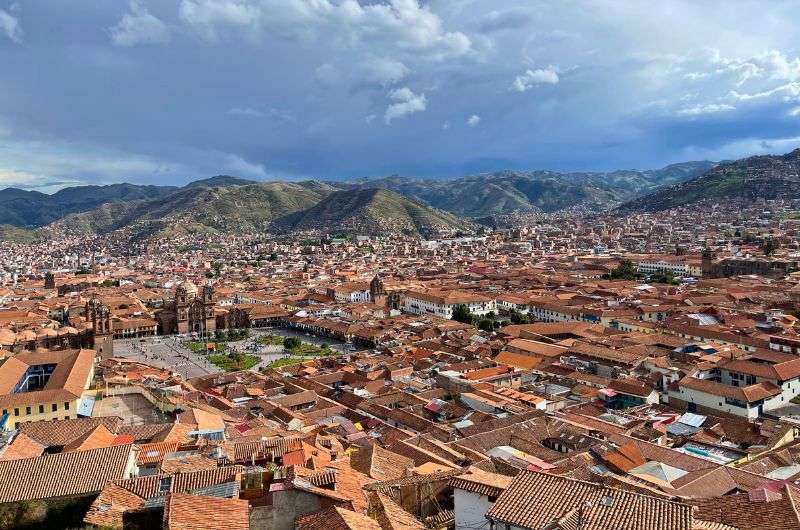
Your Machu Picchu trip starts in Cusco
Here’s a breakdown of your transportation options:
- Step 1: Cusco to Ollantaytambo (Distance: 72 km/45 miles)
- Taxi or rental car: The drive takes about 1.5 hours. Taxis cost around USD 40. There is parking by the Ollyantaytambo train station for PEN 15 (USD 4) per day.
- Bus or shared van (colectivo): Cheap, slow, and uncomfortable, costing around USD 5–10. (To be avoided unless… actually, there’s never a good reason to take the bus.)
- Pro tip: If you don’t want to rent a car or hire a taxi for some reason, opt for a combination ticket for the bus+train from one of the two Machu Picchu train operators: PeruRail or IncaRail. They take you from Cusco all the way to Aguas Calientes in semi-comfort for USD 50–120 total (the sooner you buy the better!).
- Taxi or rental car: The drive takes about 1.5 hours. Taxis cost around USD 40. There is parking by the Ollyantaytambo train station for PEN 15 (USD 4) per day.
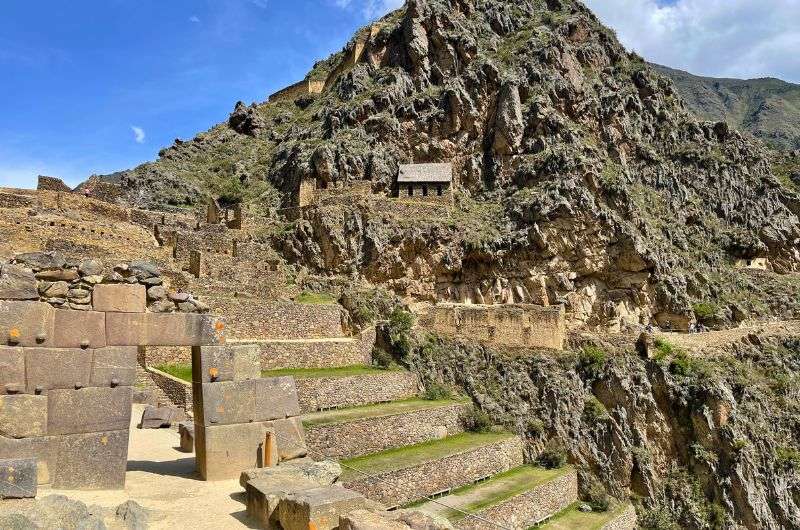
Moving on via Ollantaytambo
- Step 2: Ollantaytambo to Aguas Calientes (Machu Picchu Pueblo) (Distance: 30 km / 18.6 miles)
- Train:
- Peru Rail or Inca Rail options.
- The scenic 1.5-hour train ride costs between USD 50–120 one way, depending on the class and season you are traveling in. Buy in advance to avoid high prices.
- Pro tip: No need to splurge for better seats, basic tourist class is perfectly fine—these trains are nice and you get incredible views even from the cheapest seats.
- Peru Rail or Inca Rail options.
- Walking (for the hardcore):
- You can walk 28 km/17.4 miles along the train tracks from Ollantaytambo to Aguas Calientes (about 6–7 hours). Honestly, not recommended unless you love a long, sweaty hike before an even longer, sweatier hike!
- Train:
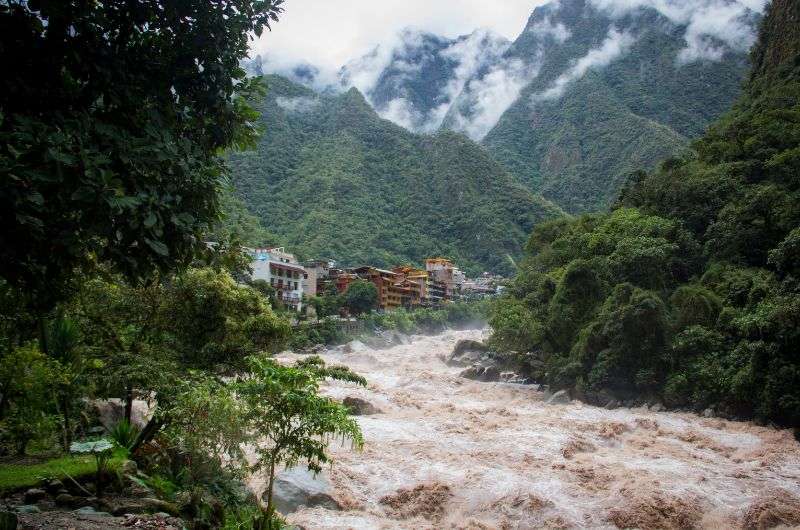
The last stop before Machu Picchu is Aguas Calientes
- Step 3: Aguas Calientes to Machu Picchu Inca ruins (Distance: 9 km / 5.6 miles)
- Bus to Machu Picchu:
- 20-minute bus ride up a zigzagging mountain road, costs USD 24 round-trip. Buses run frequently and are first come, first served.
- Buy your ticket at the Consettur office in Aguas Calientes.
- 20-minute bus ride up a zigzagging mountain road, costs USD 24 round-trip. Buses run frequently and are first come, first served.
- Walking:
- If you’re feeling adventurous (or didn’t get bus tickets), the hike takes 1.5–2 hours and is 9 km (5.6 miles). It’s steep and you’ll be walking on the same road the buses are zooming up and down. Not recommended.
- Bus to Machu Picchu:
7. Taking the train from Ollantaytambo to Aguas Calientes: My experience
Most people will be coming from Cusco (because it has an airport, and because it is awesome—get my Cusco guide), but the real trip to Machu Picchu starts in a town called Ollantaytambo. We drove there from Cusco in about an hour.

In Ollantaytambo, to reach Machu Picchu, we first boarded the extortionate train (USD 120?!) for the 1,5-hour trip to Machu Picchu Pueblo. Honestly the train ride in itself could pass for a tourist attraction, it was so good!
I took a Peru Rail train and enjoyed the trip beer in hand, eyeballs falling out of my head the whole way, staring at the almost 5,500 m (18,000 ft) mountains. You will be guided through what you are seeing out the windows the whole way through the speakers in the train.
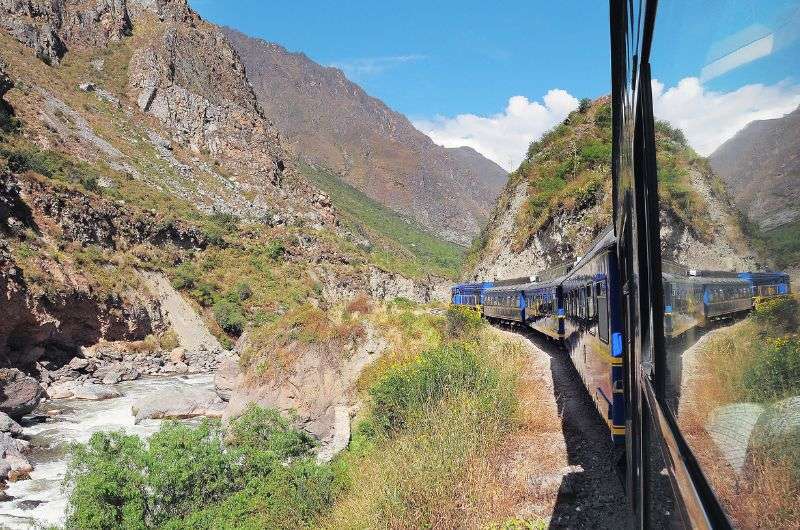
The train ride is pleasant and full of views
There are two train companies to choose from when you’re traveling from Ollantaytambo to Aguas Calientes: Peru Rail and Inca Rail. I think they are interchangeable, just choose the one whose departure time suits you best.
There both sell fancy 360º observation car seats, but I don’t think it’s necessary to pay extra for anything but the basic class… and you know I’m always the first to opt for comfort. The views are what matter and those are the same for everyone, and the windows were very big and seats were good enough in regular class as well.
Make sure to get to the train station 30 minutes beforehand to be on the safe side, and have your passport ready.
8. The bus from Aguas Calientes to Machu Picchu: My experience
In Aguas Calientes, your next task is to secure bus tickets to the top of the mountain.
The bus to Machu Picchu is only a 20-minute ride, but you’ll be either glued to your window enjoying the views or hoping you won’t die when the bus falls over the edge of the terrifyingly narrow roads. Be ready for lots of sharp bends. I did feel safe—our driver wasn’t going crazy fast and some of the seatbelts even worked!
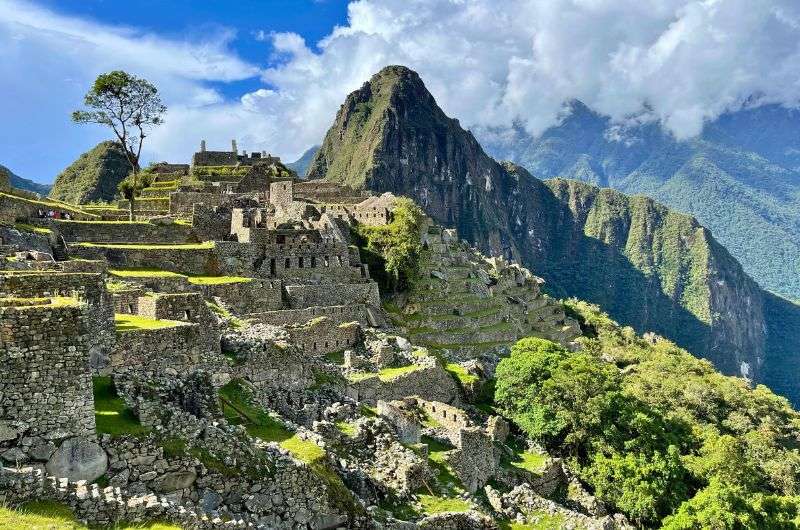
Now just get on the bus and you're there—Machu Picchu!
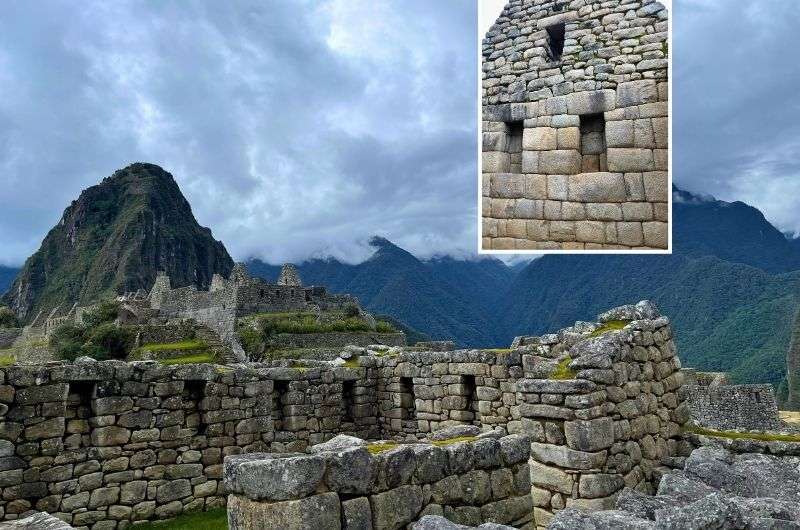
You have 4 hours to explore the entire Machu Picchu site
The train stops conveniently in town, so once you leave the small train station you just take a short walk through the market, walk over the bridge and that’s where the buses depart from.
The official bus ticket agency, Consettur, is in the adjacent alley. Buy your bus tickets there, the price is USD 24 round trip—tell me you have a monopoly without telling me you have a monopoly. Cash and credit cards are accepted, though paying with a card results in a 5% surcharge. You will need your passport!
Plan to get to the bus stop at least 30 minutes before your scheduled Machu Picchu time slot (see more about how tickets work below), as buses depart when full and work on a first come, first served basis. The first one leaves at 5:30 am, so if you’re one of those people who wants to see the sunrise, get ready to queue up early. And I mean like 4:30 am early! The last buses leave around 3:30 pm.
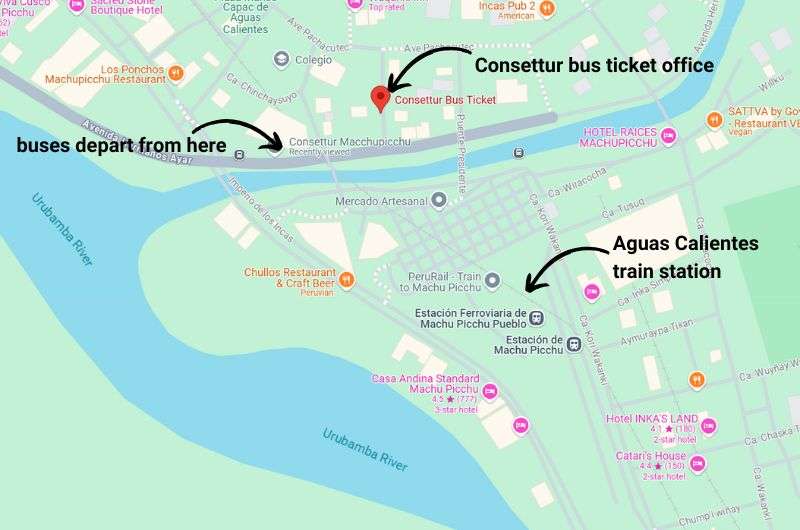
This map shows the “Estacion Machu Picchu” (train station), the Consettur bus ticket office across the river, and the departure point for the buses (you can’t miss it—just stand in the very long line)
9. How to get to Machu Picchu from Lima: Just add a flight to Cusco
The quickest way to get to Machu Picchu from Lima is to first fly from Lima to Cusco (around 1.5 hours). Then, from Cusco, make your way to Ollantaytambo, which takes another 1–2 hours depending on your mode of transportation. Then you hop on the train to Aguas Calientes, and finally, you’re just a 20-minute bus ride from the Inca citadel! I’ve described the trip from Cusco above in detail.
Pro tip: I can’t sit here and tell you to fly straight from Lima to Cusco with a clear conscience. The altitude difference is extreme—Lima is at 154 m (505 ft), while Cusco is up at 3,400 m (11,150 ft)—and it’s the perfect recipe for altitude sickness if you do it this way. Instead, I recommend adding a stop in Arequipa, which is at a more manageable 2,335 m (7,660 ft). This way, you can ease into the higher altitudes gradually.
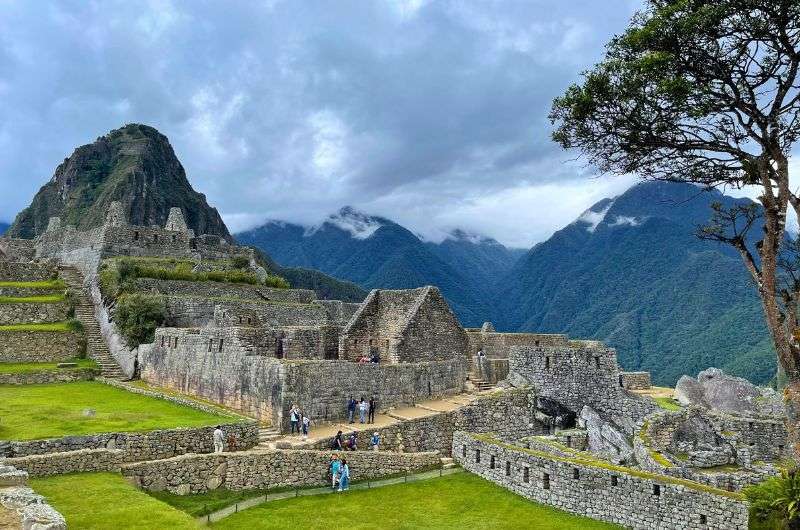
From Lima to Cusco, from Cusco to Machu Picchu
10. Machu Picchu tickets system explained (new rules for 2024/5)
Let’s talk about Machu Picchu tickets, because if you’re not on top of this, you could end up in Aguas Calientes staring longingly at a photo of the Inca citadel instead of the real thing.
First off, you need to buy your tickets in advance—and I mean months in advance if you’re visiting during the peak season (June-August). Tickets are sold in hourly time slots, and once you enter, you’ve got 4 hours to explore. No re-entry, no turning back. If you’re late for your time slot (or forget your passport), you won’t be let in. Choose your time carefully!
Machu Picchu now operates on 3 main circuits, which are further divided into 10 different routes. Each route determines where you’ll go within the site. And no, you can’t change your mind last minute. You are locked into whichever route you choose when buying your ticket.
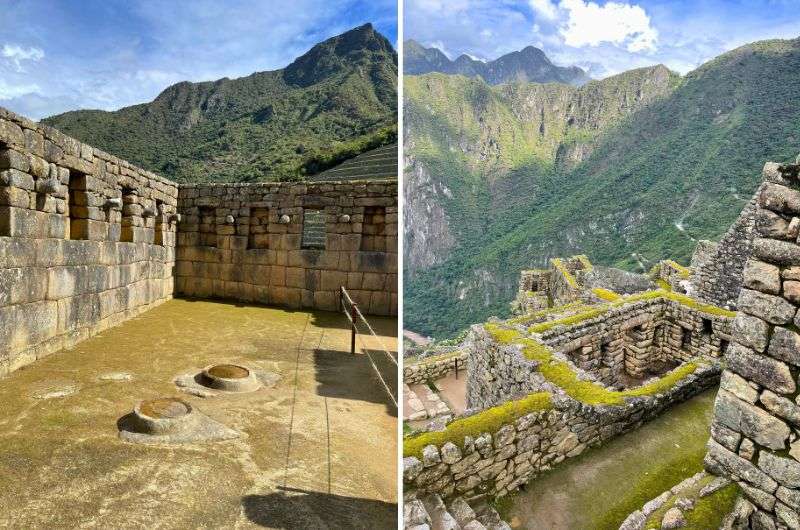
There are a total of 10 different routes to choose from at Machu Picchu
Circuit 1 (Panoramic Circuit): Machu Picchu Mountain and short routes
Focuses on iconic panoramic views from the upper terraces. Includes options like Route 1-A, which gives access to Machu Picchu Mountain, or Route 1-B, which takes you to the classic postcard viewpoints on a pretty short 1.6 km (1 mi) walk. I’m not sure why anyone would want to do just a brief visit like that, but it’s an option.
If you visit in high season (June to October), you can also hike to the Sun Gate or the Inca Bridge (Routes 1-C and 1-D).
Circuit 2 (Classic Circuit): Perfect for first-timers at Machu Picchu
The most comprehensive route and the route you want if you’re looking to visit the most important places in the Inca citadel, giving you the classic photo op and access to the main archaeological sites like the Temple of the Sun, Sacred Plaza, and Temple of the Condor. Perfect for first-time visitors. You get a choice of the classic and lower route, both about a 2.5 km (1.5 mi) loop (they’re almost entirely the same aside from a couple of viewpoints).
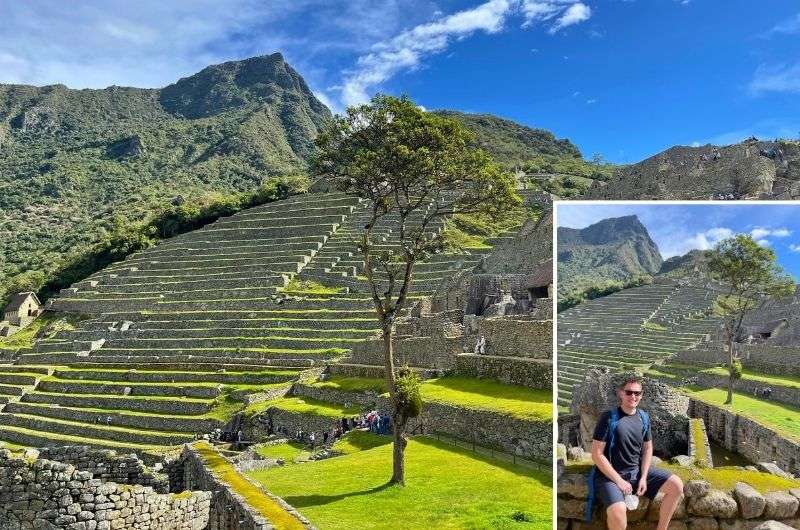
Take time to choose the right circuit so you see everything you want to see at the Inca citadel
Circuit 3 (Royalty Circuit): The one with the Huayna Picchu hike
Focuses on the lower part of Machu Picchu including the most sacred spaces occupied by Inca royalty, including the Temple of the Sun, the House of the Inca, the Temple of the Condor.
This is the circuit that you need to purchase if you want to climb Huayna Picchu (Waynapicchu)—this was my choice and it was epic! And scary! Read below.
In high season only, you can choose to visit Huchuy Picchu or the Great Cavern.
11. Machu Picchu opening times and ticket time slots
Machu Picchu is open daily 6 am–5:30 pm. Tickets are sold in hourly time slots starting with 6 am–7 am, with the last entry slot being 3 pm–4pm. A tickets grants you 4 hours at Machu Picchu from the time you enter.
Hike routes (like Huayna Picchu) are only available in 2 morning time slots and are sold out faster than regular tickets.
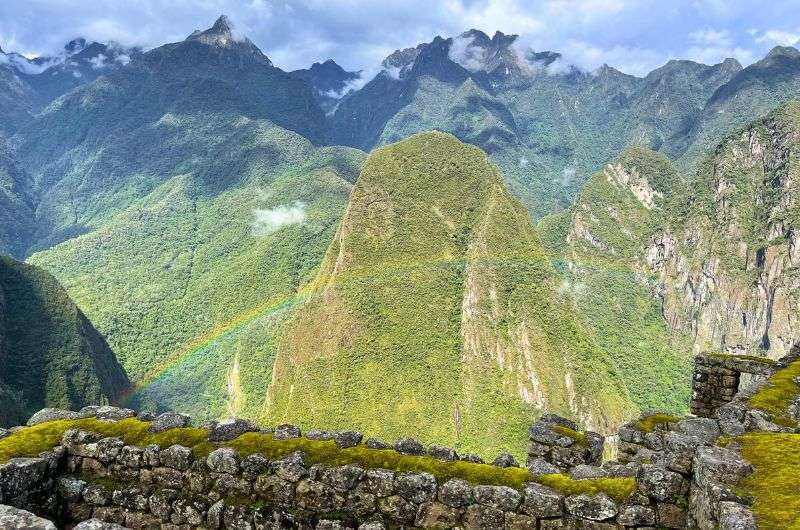
I was lucky enough to catch a rainbow in my photo!
12. Machu Picchu entrance fees: PEN 152 or PEN 200
Following the ticket system update in 2024, tickets to Machu Picchu cost:
- PEN 150 (USD 40) for classic routes without hikes
- PEN 200 (USD 53) for routes with hikes such as to Machu Picchu Mountain and Huayna Picchu Mountain
The prices above are for foreign adults. Students, minors, and locals pay less.
13. Buy Machu Picchu tickets on the new official website (visiting without a tour)
The Ministry of Culture has set up a good website for Machu Picchu ticket purchases and it works surprisingly well! Every circuit is well explained on there and includes maps. To buy tickets, you simply choose your date, times, nationality, and off you go.
Buy your tickets online as soon as you know your travel dates, ideally several months in advance if you’re traveling in peak season (June to August), and at least a month in advance in other months.
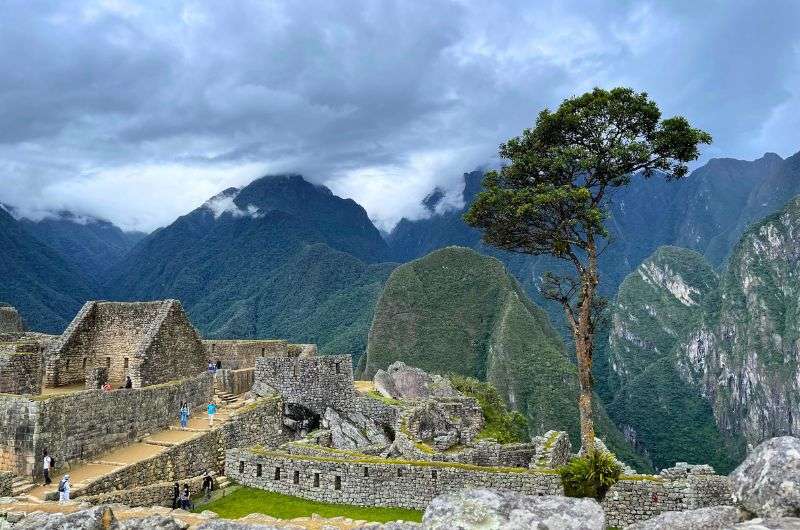
Machu Picchu view no. 265
Beware: You can’t buy tickets for 2025 before January 2025!
A “little” glitch in the new system they may or may not iron out is that tickets for 2025 will only start being sold in January 2025. If you’re visiting Machu Picchu at the beginning of next year, good luck! The only thing you can do at the moment is keep checking back for updates to get your tickets before everyone else does once they go on sale.
14. My tips for buying tickets for Machu Picchu: Follow these steps
Before you buy your tickets, take a good look at the “how to get to Machu Picchu” section of this article. Since the logistics are multi-step, you want to think before you click (on the “buy” button) so you don't get stuck in Aguas Calientes for five hours before your ruins visit or something like that.
Follow these steps to purchase Machu Picchu tickets:
- Think about when you’d like to visit Machu Picchu, look at the available date and time slots, but don’t buy yet.
- Check train times and availability that will get you to Aguas Calientes about 1 to 1.5 hours before your desired Machu Picchu entry time. If you’re aiming for sunrise, you need to get to town the night before.
- Once you’ve matched your train time to your desired Machu Picchu ticket, buy your train tickets.
- Only then is it safe to buy your Machu Picchu tickets.
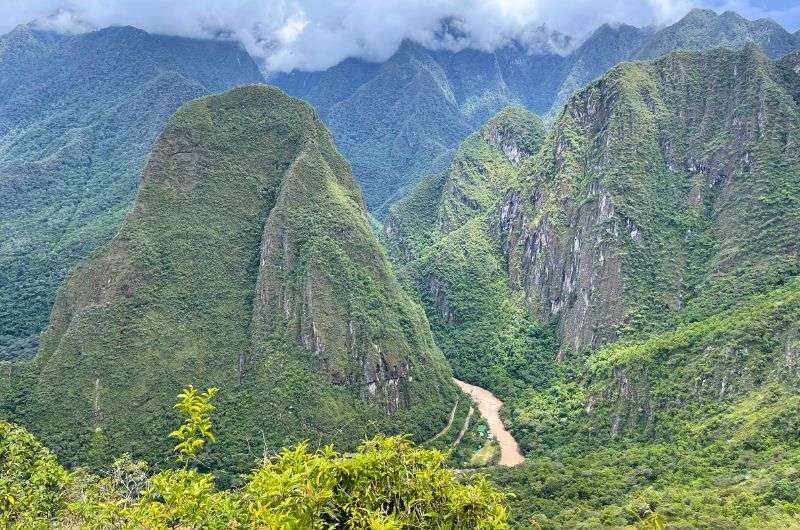
It's pretty high up... but not as high as Cusco!
15. How long in advance should you buy your Machu Picchu tickets?
Get your tickets 3 months in advance if traveling in high season (June–August), a month in advance at other times of the year—this is if you’re planning on seeing just the Inca city of Machu Picchu and nothing else.
If you’re hoping to do some of the hikes (which I highly recommend!), make that 3 months in advance, and as much as 6 months prior to your trip if you’re traveling during the peak season. Unlike the tickets for the city with are sold throughout the day, there are only 2 morning time slots per day for the treks, with a capacity of just a couple of hundred people daily. These tickets are HOT.
16. Climbing Huayna Picchu mountain: My experience
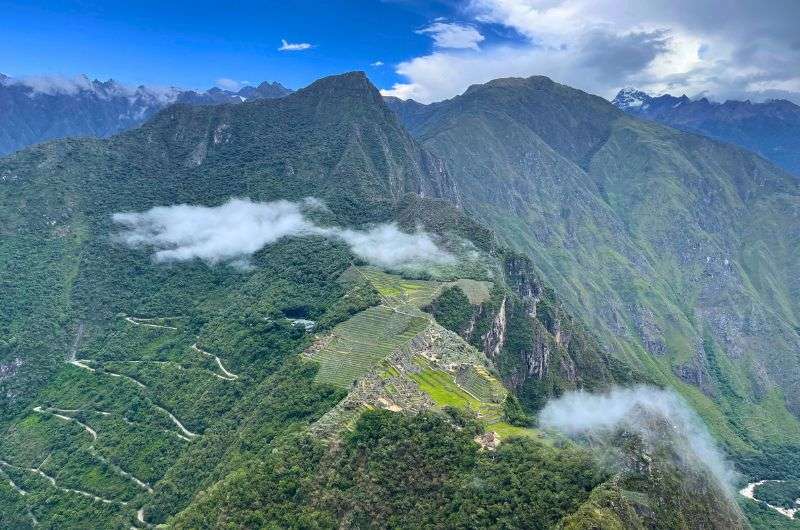
The view from Huayna Picchu mountain
The most spectacular of all the available Machu Picchu hikes is the one to the top of Huayna Mountain (aka Waynapicchu). This is the one we took and if you have the physical capability and aren’t especially scared of heights, I highly recommend it!
Getting to the 2,700 m (9,000 ft) summit is not for the faint of heart. Most of the way you’ll be walking up steep stone steps, so steep that at the top section you’ll be on all fours basically climbing like you would a ladder.
There are cables to hold on to, but the drop-off to the side is nuts in some points. Beware that some areas are very narrow. Santa Claus wouldn’t fit, if you know what I mean.
It takes a little over an hour one way, but it is one heck of a climb; expect to need to take breaks. Once you make it to the top, you’ll be 360 meters (1,200 feet) above Machu Picchu city, which is one of the coolest viewpoints I’ve ever seen!
Sometimes, all you need to do is take the first step... I've filtered out the best hotels in Machu Picchu for you
Save it for yourself to come back to later, or share with your friends on social media!
I've already planned your ititnerary for the trip, complete with my travel tips.
17. Do you need a guide for Machu Picchu? Officially, yes you do
Yes, guides are officially mandatory at Machu Picchu as of the latest regulations. However, enforcement of this rule can be inconsistent. While the rule requires visitors to be accompanied by a licensed guide to help preserve the site, I’m still getting reports that guides are not always strictly enforced at the entrance.
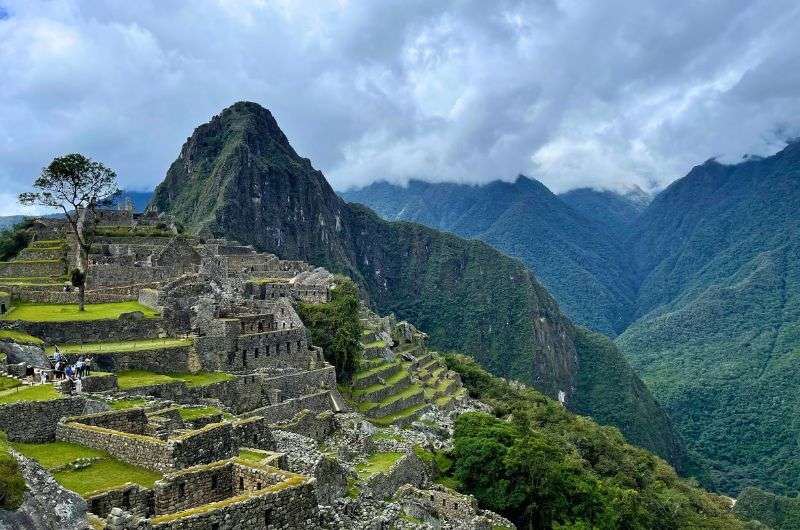
Hiring a guide for Machu Picchu is beneficial
That said, having a guide is definitely beneficial. There are no information panels at Machu Picchu.
A guide will cost you PEN 200–300 for two people and the guided tour takes about 2.5 hours. You can find your guide either in Machu Picchu Pueblo or at the entrance to the actual ruins. When you’re waiting for your bus, you may be told by some of the guides that you have to hire them there because there aren’t any available at the top, but alas, there are tons of them at the entrance.
There are two types of guides. I nicknamed the first type “radio” because they don’t actually speak any English, instead just reciting the information they have learned (in English). The second type can speak a little bit of English, which is nice if you want to ask questions about what you’re looking at inside. When hoping to get the second type, try asking them to tell you a little about themselves. You’ll weed out the radios pretty quickly.
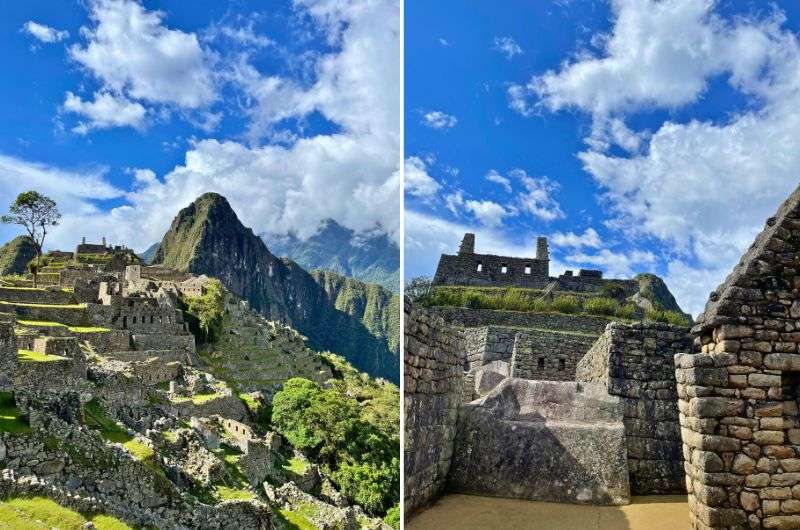
Machu Picchu guides are well qualified, though not all are strong English speakers
That said, know that in order to become a Machu Picchu guide, I learned that they have to study very hard and pass some serious tests, so whichever person you choose has deserved their right to do this job.
18. Best time to visit Machu Picchu (month and time of day)
Machu Picchu has fairly steady daytime temperatures around 20°C (68°F) year-round, but the weather is all about the seasons.
The dry season (April to October) is your best bet for clear skies, though you'll be sharing the views with more tourists. The wet season (November to March) brings rain showers, mostly in the afternoons, but it’s also when you’ll have fewer crowds and cheaper prices at hotels, on trains, at rental car companies, etc. We went in January and had a fantastic time, so don’t shy away just because of a higher chance of rain.
Even in the dry season, it can still rain occasionally at Machu Picchu—this is the edge of a rainforest, after all. But if it does rain, it’s usually just a short shower. During July, which is the coldest month, nighttime temperatures can dip to 0°C (32°F), so bring layers.
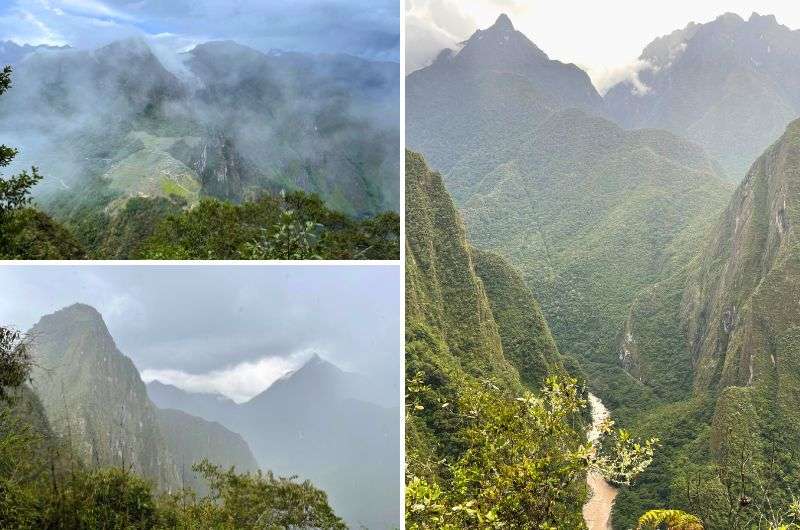
If you want to go to Machu Picchu in the morning, be prepared for fog
Mornings are known to be foggy—keep that in mind if you’re thinking about going in for sunrise. Afternoons are when you have the highest chance of rain, but if skies are clear, the lighting is magical. Also, since the crowds tend to thin out after midday because most visitors who arrived early begin to leave after they’ve completed their morning tours or hikes, the routes tend to feel less busy.
For a full breakdown of when to visit—including tips for sunrise and sunset visits—check out my detailed guide:

Is Cusco colder than Machu Picchu?
Yes, Cusco is generally colder than Machu Picchu. At 3,400 m (11,150 ft) above sea level, it’s much higher than Machu Picchu, which sits at 2,430 meters (7,970 feet). Expect Cusco to be chillier, especially at night, while Machu Picchu enjoys milder temperatures.
19. Altitude of Machu Picchu: Should you be worried?
Machu Picchu itself isn’t too concerning when it comes to altitude—it sits at 2,430 m (7,970 ft), which is considered high, but most people can handle it without major issues. However, if you're sensitive to altitude or coming from sea level, you might feel a bit winded, especially if you're doing a lot of walking or hiking. The air is thinner, so just take it easy and stay hydrated. You can read up on altitude sickness and its prevention in my article.
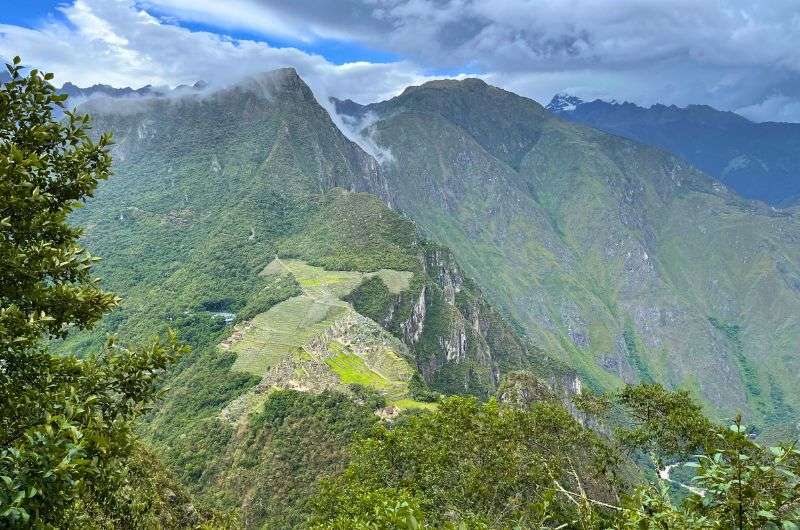
At 2,430 m (7,970 ft), Machu Picchu is pretty high up, but most people won’t have trouble with altitude sickness at this altitude
20. Animals of Machu Picchu:
Llamas are the unofficial mascots of Machu Picchu, and you’ll likely spot them roaming around the ruins, casually photobombing your perfect shots. These animals were important to the Incas, and today they help maintain the site's natural grasslands. Natural lawnmowers, you know?
Besides llamas, keep an eye out for Andean condors, vizcachas (cute little rabbit-like creatures), and various bird species.
Just remember that Machu Picchu is a protected site. Avoid feeding the animals or disturbing their habitats.
Aren’t they alpacas? No, alpacas are more commonly found in other areas of the Andes, particularly in places like Cusco and the Sacred Valley, where they are raised for their wool. So, while you may see alpacas elsewhere in Peru, Machu Picchu is llama territory!

21. Hiking to Machu Picchu on the Inca Trail
I did not do the Inca Trail, instead sleeping in a comfy bed, taking the fantastic train journey, and hiking to Huayna Picchu once at the final destination. Although I like my hikes, I know how to pick my battles.
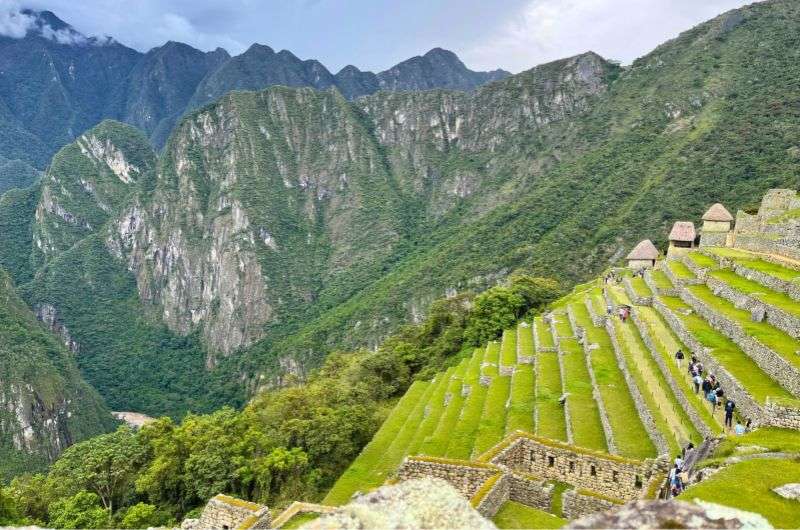
The Inca Trail is very popular and needs to be booked in advance
The Inca Trail is insanely popular. So popular, in fact, that the government has limited permits to 500 people per day, which includes hikers, guides, and porters. You have to book months—sometimes 6 months—in advance, especially during peak season (June-August).
The classic Inca Trail is 4 days hiking 26 miles (42 km) through moderately-difficult terrain at a high altitude, camping along the way.
There are other, shorter variants of the trail that you can choose from, but you’ll need to do your own research there. Like I said, I reached Machu Picchu without hiking, as part of a self-guided tour that didn’t require any tents. Can you tell I hate tents?
I’ve already mentioned the incredible Sumaq Machu Picchu Hotel in Aguas Calientes, which is where you should stay instead of a tent on the Inca trail. Actually, if you stay here after the Inca Trail, you’ll probably be the seventh-est of seventh heavens.
This post contains affiliate links. I earn a small commission if you make bookings through my links, at no additional cost to you. Thank you for your support!










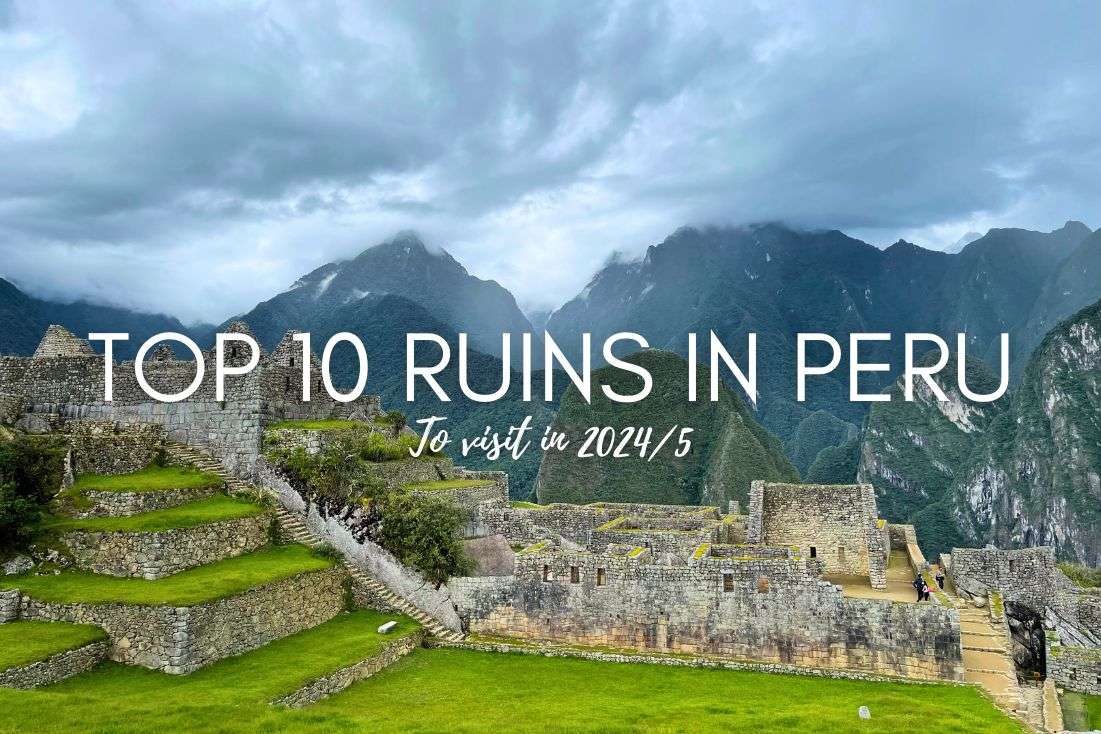
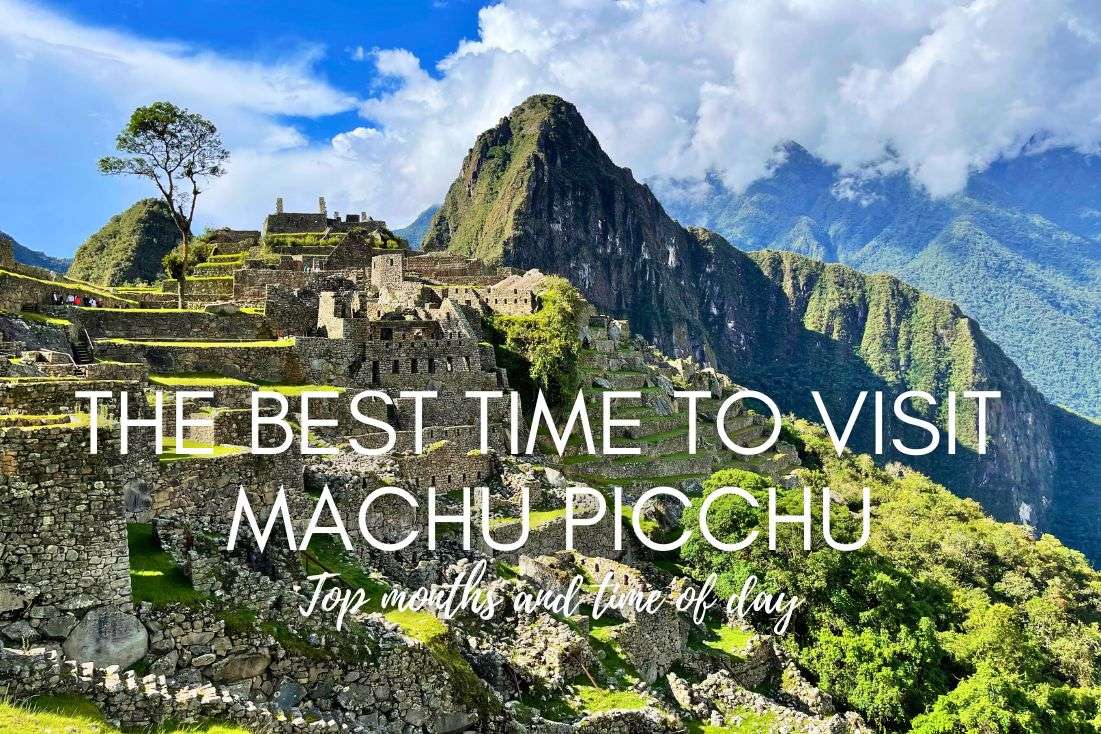
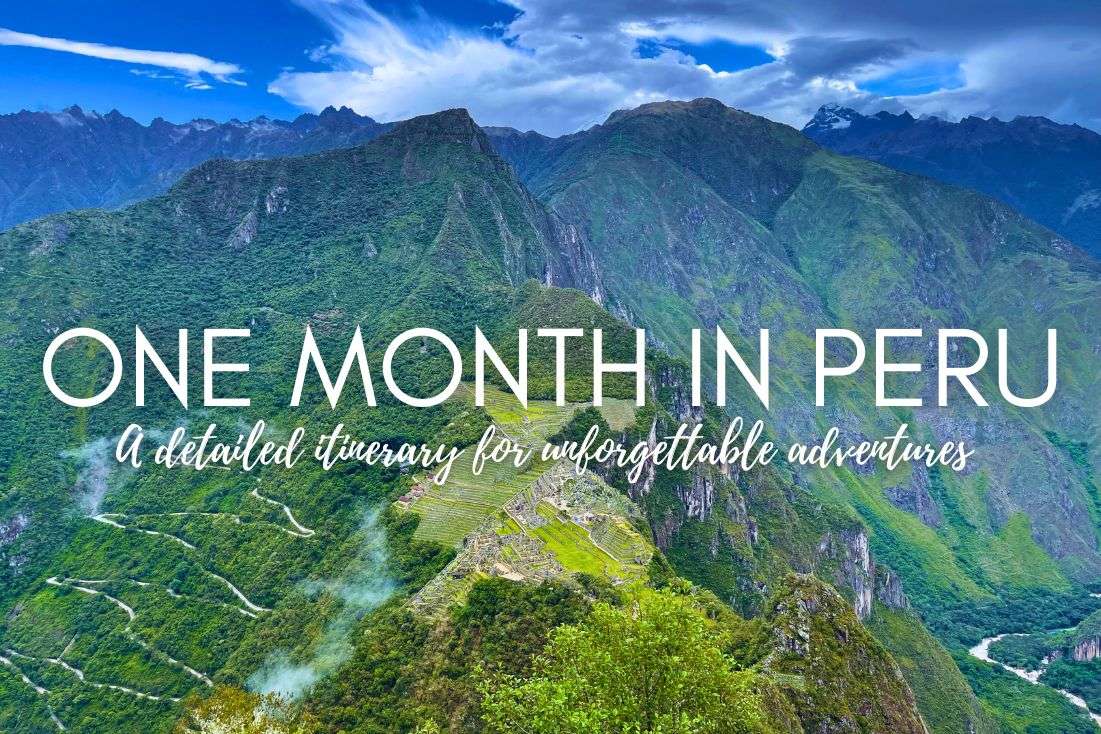



Comments | Thoughts? Give us a shout!